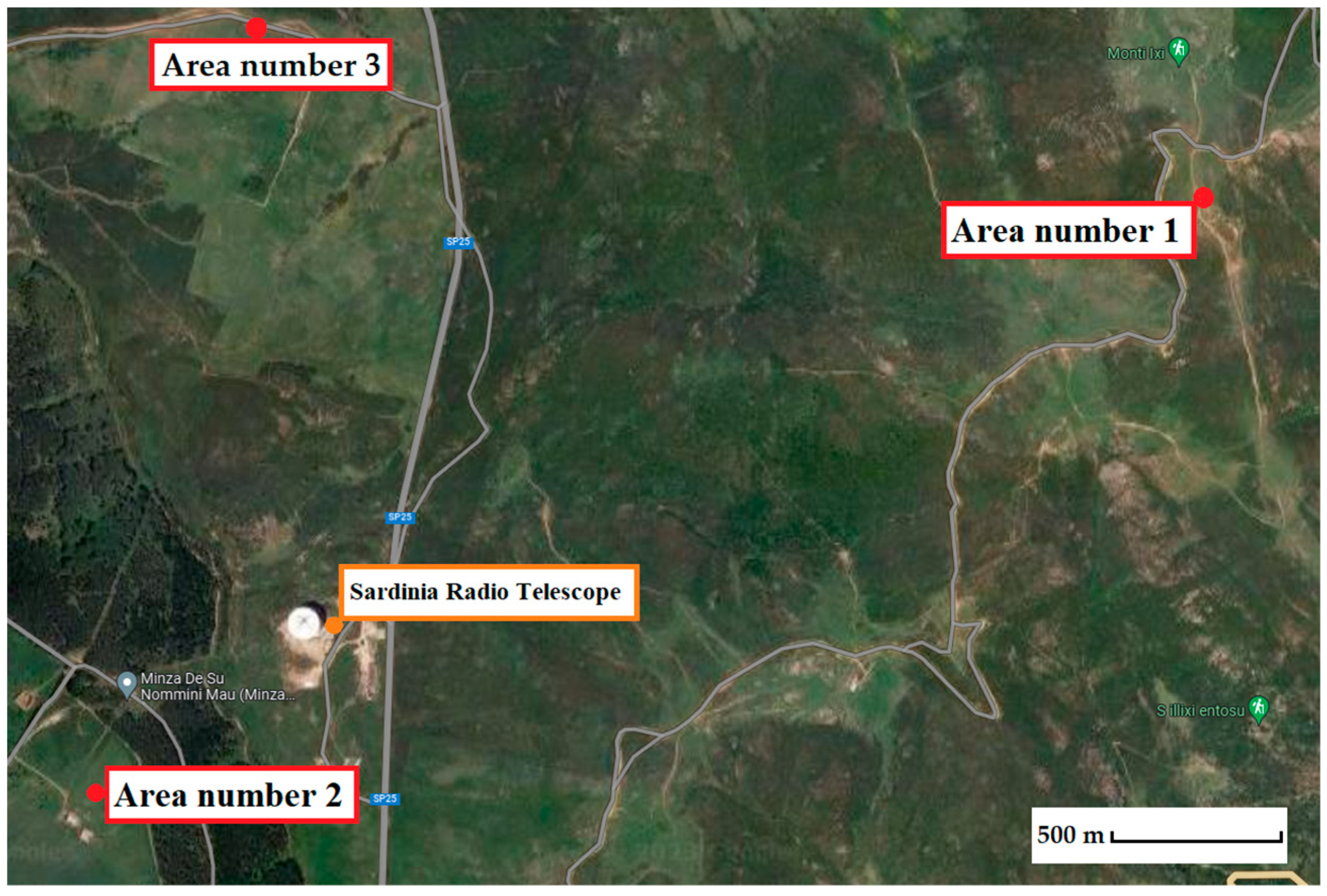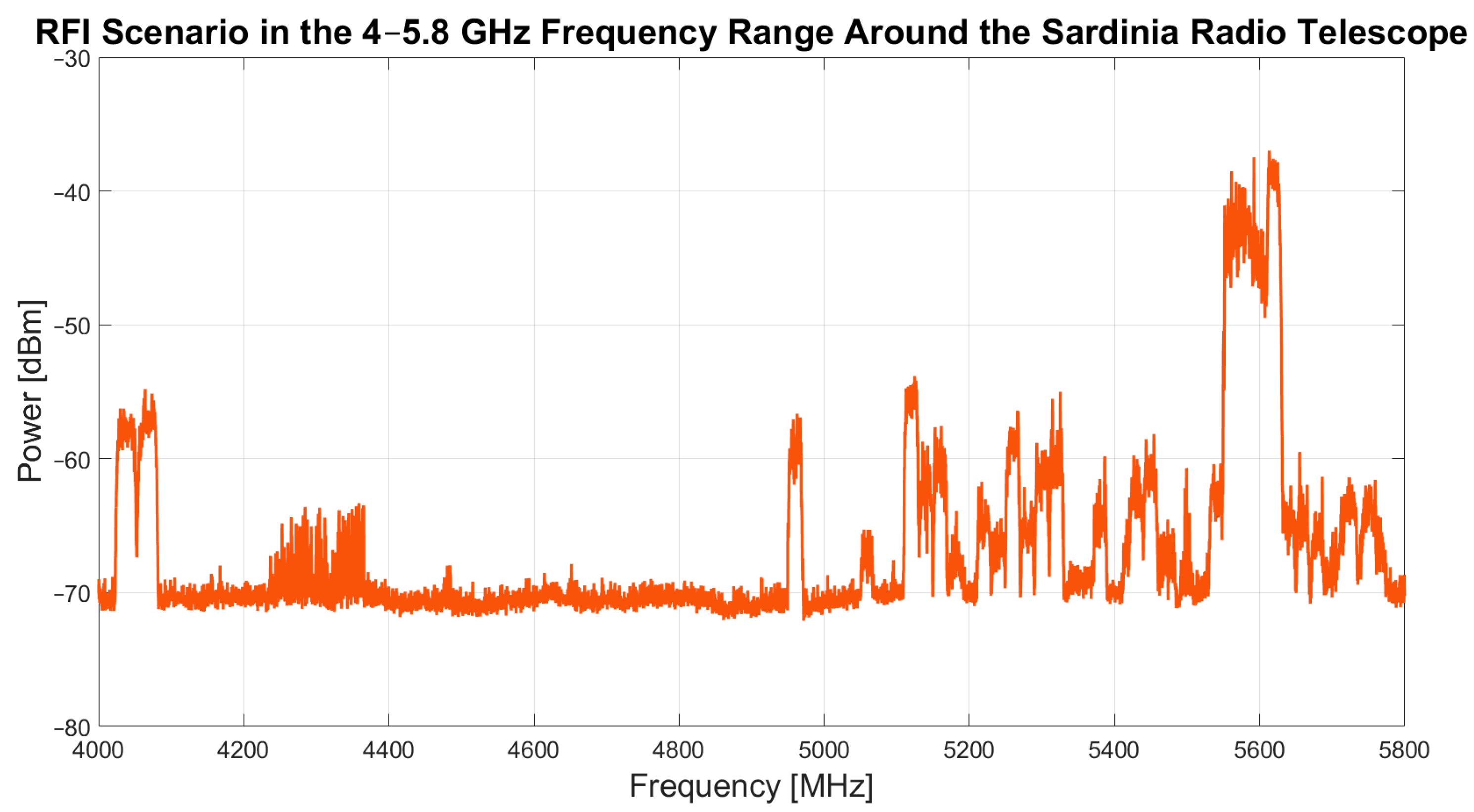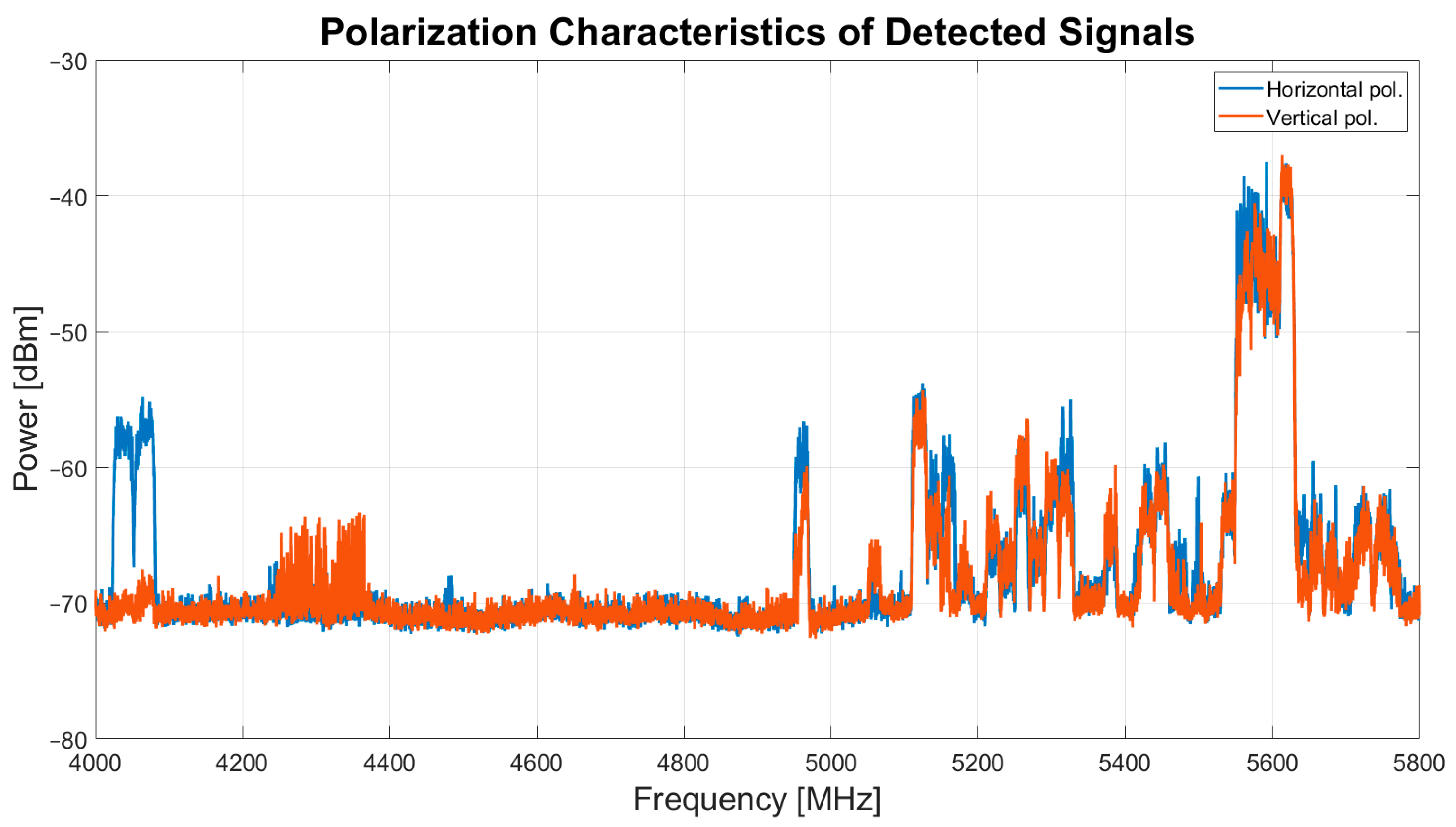Measurement Campaign of Radio Frequency Interference in a Portion of the C-Band (4–5.8 GHz) for the Sardinia Radio Telescope
Abstract
:1. Introduction
2. Materials and Methods: Description of the Measurement Setup
2.1. Description of the Measurement Scenario
- Area number 1: a point on Monte Ixi mountain (lat. 39.50075958202559° N, long. 9.26616912945711° E), located approximately 2 km from the SRT as the crow flies;
- Area number 2: a point in the Union of Municipalities of Gerrei, called Colonia Montana (lat. 39.4900647290649° N, long. 9.23939203600374° E), located at about 600 m from the SRT as the crow flies;
- Area number 3: a point on the pasture land in front of the telescope (lat. 39.503814094404156° N, long. 9.245117265226954° E), placed approximately 1 km from the SRT as the crow flies.
2.2. Description of the INAF Mobile Laboratory
3. Results and Discussion
4. Conclusions and Future Work
Author Contributions
Funding
Institutional Review Board Statement
Informed Consent Statement
Data Availability Statement
Acknowledgments
Conflicts of Interest
References
- Emery, W.; Campus, A. Chapter 4—Microwave Radiometry. In Introduction to Satellite Remote Sensing: Atmosphere, Ocean, Cryosphere and Land Applications; Elsevier: Amsterdam, The Netherlands, 2017; pp. 131–290. [Google Scholar]
- Querol, J.; Perez, A.; Camps, A. A Review of RFI Mitigation Techniques in Microwave Radiometry. Remote Sens. 2019, 11, 3042. [Google Scholar] [CrossRef]
- Ladu, A.; Schirru, L.; Gaudiomonte, F.; Marongiu, P.; Angius, G.; Perini, F.; Vargiu, G.P. Upgrading of the L-P Band Cryogenic Receiver of the Sardinia Radio Telescope: A Feasibility Study. Sensors 2022, 22, 4261. [Google Scholar] [CrossRef] [PubMed]
- Ford, J.M.; Buch, K.D. RFI mitigation techniques in radio astronomy. In Proceedings of the 2014 IEEE Geoscience and Remote Sensing Symposium, Quebec City, QC, Canada, 13–18 July 2014. [Google Scholar] [CrossRef]
- Khan, I.; Raut, A.; Sureshkumar, S. Design of Switchable Hairpin Band Pass Filters for Low Frequency Radio Astronomy 2019. In Proceedings of the IEEE MTT-S International Microwave and RF Conference (IMARC), Mumbai, India, 13–15 December 2019. [Google Scholar] [CrossRef]
- Schirru, L.; Ladu, A.; Gaudiomonte, F. Radio Frequency Interference Measurements to Determine the New Frequency Sub-Bands of the Coaxial L-P Cryogenic Receiver of the Sardinia Radio Telescope. Universe 2023, 9, 390. [Google Scholar] [CrossRef]
- Tarongi, J.M.; Camps, A. Radio Frequency Interference Detection and Mitigation Algorithms Based on Spectrogram Analysis. Algorithms 2011, 4, 239–261. [Google Scholar] [CrossRef]
- Wang, Y.; Zhang, H.; Wang, J.; Huang, S.; Hu, H.; Yang, C. A Software for RFI Analysis of Radio Environment around Radio Telescope. Universe 2023, 9, 277. [Google Scholar] [CrossRef]
- Baan, W.A. Implementing RFI mitigation in radio science. J. Astron. Instrum. 2019, 8, 1940010. [Google Scholar] [CrossRef]
- Abidin, Z.Z.; Adnan, S.; Ibrahim, Z.A. RFI profiles of prime candidate sites for the first radio astronomical telescope in Malaysia. New Astron. 2010, 15, 307–312. [Google Scholar] [CrossRef]
- Prayag, V.; Beeharry, G.K.; Vydelingum, N.; Inggs, M. RFI in Mauritius. In Proceedings of the 2016 Radio Frequency Interference (RFI), Socorro, NM, USA, 17–20 October 2016. [Google Scholar] [CrossRef]
- Sitompul, P.P.; Manik, T.; Batubara, M.; Suhandi, B. Radio Frequency Interference Measurements for a Radio Astronomy Observatory Site in Indonesia. Aerospace 2021, 8, 51. [Google Scholar] [CrossRef]
- Peng, B.; Sun, J.M.; Zhang, H.I.; Piao, T.Y.; Li, J.Q.; Lei, L.; Luo, T.; Li, D.H.; Zheng, Y.J.; Nan, R. RFI test observations at a candidate SKA site in China. Exp. Astron. 2004, 17, 423–430. [Google Scholar] [CrossRef]
- Cohen, J.; Spoelstra, T.; Amborsini, R.; van Driel, W. CRAF Handbook for Radio Astronomy, 3rd ed.; European Science Foundation: Strasbourg, France, 2005; pp. 141–145. [Google Scholar]
- SRT—Sardinia Radio Telescope. Available online: http://www.srt.inaf.it/ (accessed on 10 September 2024).
- Orfei, A.; Cresci, L.; Marongiu, P.; Nesti, R.; Panella, D.; Bolli, P.; Sonnini, A.; Cattani, A.; Maccaferri, A.; Mariotti, S.; et al. Il Ricevitore 4.2–5.6 GHz per SRT; INAF Technical Reports—Rapporti Tecnici; INAF: Rome, Italy, 2024; Volume 292, Available online: http://hdl.handle.net/20.500.12386/34821 (accessed on 10 September 2024).
- Prandoni, I.; Murgia, M.; Tarchi, A.; Burgay, M.; Castangia, P.; Egron, E.; Govoni, F.; Pellizzoni, A.; Ricci, R.; Righini, S.; et al. The Sardinia Radio Telescope, From a technological project to a radio observatory. Astron. Astrophys. 2017, 608, 26. [Google Scholar] [CrossRef]
- Bolli, P.; Beltrán, M.; Burgay, M.; Contavalle, C.; Marongiu, P.; Orfei, A.; Pisanu, T.; Stanghellini, C.; Tingay, S.J.; Zacchiroli, G.; et al. A Review of Front-End Receivers for the INAF Radio Telescopes. In Proceedings of the Second URSI Atlantic Radio Science Meeting, Gran Canaria, Spain, 28 May–1 June 2018. [Google Scholar] [CrossRef]
- Bolli, P.; Gaudiomonte, F.; Ambrosini, R.; Bortolotti, C.; Roma, M.; Barberi, C.; Piccoli, F. The mobile laboratory for radio-frequency interference monitoring at the Sardinia radio telescope. IEEE Antennas Propag. Mag. 2013, 55, 19–24. [Google Scholar] [CrossRef]
- Bolli, P.; Gaudiomonte, F.; Ambrosini, R.; Bortolotti, C.; Roma, M. The Receiving System of the Mobile Laboratory for RFI Measurements; INAF Technical Reports—Rapporti Tecnici; INAF: Rome, Italy, 2012; Volume 20, Available online: http://hdl.handle.net/20.500.12386/1260 (accessed on 10 September 2024).
- ARA Technologies: Horn Antennas 200 MHz—40 GHz. Available online: https://www.emctest.it/public/pages/strumentazione/elenco/ARA/DRG-118-A%20-%20Double%20Ridged%20Horn/Datasheet/ARA-Ridge-horn.pdf (accessed on 10 September 2024).
- RLC Electronics: Type C Multi-Position Coaxial Switches (3 to 6 Position). Available online: https://rlcelectronics.com/products/switches/type-c-multi-position-sr-3c-4c-5c-6c-series/ (accessed on 10 September 2024).
- Lorch. Smiths interconnect. Available online: https://www.smithsinterconnect.com/our-company/who-we-are/our-technology-brands/lorch/ (accessed on 10 September 2024).
- Narda Miteq. AMF-6D-00101800-35-20P. Available online: https://nardamiteq.com/viewmodel.php?model=AMF-6D-00101800-35-20P (accessed on 10 September 2024).
- Rohde & Schwarz: FSV Signal and Spectrum Analyser. Available online: https://www.rohde-schwarz.com/us/products/testand-measurement/signal-and-spectrum-analyzers/rs-fsv-signal-and-spectrum-analyzer_63493-10098.html?change_c=true (accessed on 10 September 2024).
- ICOM. IC-R9500—Professional Communications Receiver. Available online: https://www.icomeurope.com/files/IC-R9500_BRO_E.pdf (accessed on 10 September 2024).
- The European Space Agency. Satellite Frequency Bands. Available online: https://www.esa.int/Applications/Connectivity_and_Secure_Communications/Satellite_frequency_bands#:~:text=C%2Dband%20(4%E2%80%938%20GHz) (accessed on 10 September 2024).
- International Telecommunications Union—Satellite Operators Challenge Mobiles’ Use of C-Band. Available online: https://www.itu.int/itunews/manager/display.asp?lang=en&year=2007&issue=08&ipage=C-band (accessed on 10 September 2024).
- Electronic Communications Committee—Report 340. Receiver Selectivity Performance of Satellite Earth Stations in the Band 3800–4200 MHz. Available online: https://docdb.cept.org/download/4019 (accessed on 10 September 2024).
- Electronic Communications Committee—Report 358. In-Band and Adjacent Bands Sharing Studies to Assess the Feasibility of the Shared Use of the 3.8–4.2 GHz Frequency Band by Terrestrial Wireless Broadband Low/Medium Power (WBB LMP) Systems Providing Local-Area Network Connectivity. Available online: https://docdb.cept.org/download/4530 (accessed on 10 September 2024).
- Electronic Communications Committee—Report 346. Technical Studies on Sharing between Weather Radars in Part of 5365–5470 MHz and EESS (Active). Available online: https://docdb.cept.org/download/4161 (accessed on 10 September 2024).






| Channel of the Front End | Component of the Receiving Chain | Frequency [GHz] | Gain at 5 GHz [dB] |
|---|---|---|---|
| Common for all channels | Dual-ridge horn antenna, model DRG-118-A from A.R.A. Technologies | 1–18 | 11.6 |
| D | Input switch, model RLC SR-6C-H from RLC Electronics | 0–18 | −0.3 |
| Band-pass cavity filter, model 8IZ5-4400/R2200-S from Lorch | 3.3–5.5 | −0.6 | |
| Output switch, model RLC SR-7C-H from RLC Electronics | 0–18 | −0.3 | |
| Amplifier, model AMF-6D-00101800-35-20P from Miteq | 0.1–18 | 42 | |
| E | Input switch, model RLC SR-6C-H from RLC Electronics | 0–18 | −0.3 |
| Band-pass cavity filter, 8IZ6-7200/R3600-S from Lorch | 5.4–9 | −0.4 | |
| Output switch, model RLC SR-7C-H from RLC Electronics | 0–18 | −0.3 | |
| Amplifier, model AMF-6D-00101800-35–20P from Miteq | 0.1–18 | 42 | |
| Common for all channels | External spiral coaxial cable | 0–18 | −15 |
Disclaimer/Publisher’s Note: The statements, opinions and data contained in all publications are solely those of the individual author(s) and contributor(s) and not of MDPI and/or the editor(s). MDPI and/or the editor(s) disclaim responsibility for any injury to people or property resulting from any ideas, methods, instructions or products referred to in the content. |
© 2024 by the authors. Licensee MDPI, Basel, Switzerland. This article is an open access article distributed under the terms and conditions of the Creative Commons Attribution (CC BY) license (https://creativecommons.org/licenses/by/4.0/).
Share and Cite
Schirru, L.; Gaudiomonte, F. Measurement Campaign of Radio Frequency Interference in a Portion of the C-Band (4–5.8 GHz) for the Sardinia Radio Telescope. Sensors 2024, 24, 6481. https://doi.org/10.3390/s24196481
Schirru L, Gaudiomonte F. Measurement Campaign of Radio Frequency Interference in a Portion of the C-Band (4–5.8 GHz) for the Sardinia Radio Telescope. Sensors. 2024; 24(19):6481. https://doi.org/10.3390/s24196481
Chicago/Turabian StyleSchirru, Luca, and Francesco Gaudiomonte. 2024. "Measurement Campaign of Radio Frequency Interference in a Portion of the C-Band (4–5.8 GHz) for the Sardinia Radio Telescope" Sensors 24, no. 19: 6481. https://doi.org/10.3390/s24196481
APA StyleSchirru, L., & Gaudiomonte, F. (2024). Measurement Campaign of Radio Frequency Interference in a Portion of the C-Band (4–5.8 GHz) for the Sardinia Radio Telescope. Sensors, 24(19), 6481. https://doi.org/10.3390/s24196481






